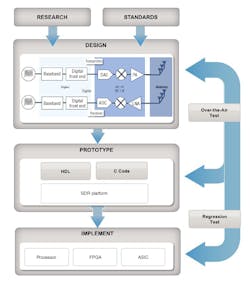This Toolbox Holds Your 5G Gear
One company on the front line of wireless communications is MathWorks, demonstrated by products like the LTE Toolbox, WLAN Toolbox, and more. Now, following the completion of the 3GPP Release 15 5G New Radio (NR) standard in June 2018, MathWorks has expanded its portfolio with the recent introduction of the 5G Toolbox.
5G will differ from 4G LTE in the types of markets it will reach. “One of the big differences with 5G is that it will go beyond mobile wireless communications,” says Ken Karnofsky, senior strategist for signal processing applications at MathWorks. “5G will extend to machine-to-machine (M2M) and vehicle-to-vehicle (V2V) scenarios, facilitating lower power and low latency.”
Of course, other factors set 5G apart from 4G LTE, too. “The 5G standard itself really specifies the baseband processing that actually constructs the signals and handles some of the network protocols,” explains Karnofsky. “The baseband physical layer is quite different than LTE in many ways. And we really see a lot of differences in the radio front-end architectures. That includes the RF components along with the antennas and antenna arrays. With aspects like massive MIMO and millimeter-wave (mmWave) operation, we’re hearing from customers that the design approach is really changing.”
Introducing the 5G Toolbox
The points mentioned highlight some of the challenges associated with creating and verifying 5G prototype systems. To help designers overcome these hurdles, MathWorks developed the 5G Toolbox. The 5G Toolbox comes equipped with standard-compliant functions and reference examples to help designers model, simulate, and verify 5G systems. It supports end-to-end link-level simulation, waveform generation and analysis, and golden reference-design verification and conformance testing.
The tools in MathWorks' 5G Toolbox can form the foundation of a workflow for designing and testing 5G products.
Designers can take advantage of the 5G Toolbox to generate standard-compliant waveforms for 5G NR specifications based on NR subcarrier spacings and frame numerologies. Link-level simulations can be performed with transmitter, channel model, and receiver operations. And designers are able to analyze link performance by computing bit-error-rate (BER) and throughput metrics.
In addition, the 5G Toolbox allows for the configuration and generation of 5G NR downlink signals and channels. It also enables users to perform end-to-end block-error rate (BLER) simulations with the help of 5G NR clustered delay line (CDL) and tapped delay line (TDL) propagation-channel models. Another feature is open, customizable algorithms, which can be used as golden references for design verification. On top of that, it’s possible to generate C code from open MATLAB algorithms.


